|
|
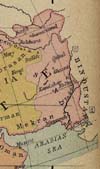 |
==Muhammad
bin Qasim in Sind (711-14): From the time of Muhammad bin
Qasim's conquest of Sind (with local collaboration) on behalf of the
Caliphate
in 711, Muslim rulers become part of the the Indian political scene.
Muhammad
bin Qasim negotiates the "Brahmanabad Settlement" (712), which grants
religious
freedom to non-Muslims. Sind becomes part of the administrative
province
of As-Sindh in the Umayyad and 'Abbasid empires from 712 to about 875.
With the eventual weakening of central authority in the Caliphate, the
Arab governors of Sind and Multan settle down and establish their own
dynastic
rule, and become part of the usual local political conflicts and
alliances.
Discussion: *Ikram
Ch. 1*. [*Routes*] |
 |
=="Arabic"
numerals--and much more: The Sind connection facilitates
cultural exchange between India and the Muslim world. An Indian scholar
brings with him to the cosmopolitan city of Baghdad a treatise on
astronomy--
and the Indian numerical system, a great improvement on earlier
Egyptian,
Greek, and Roman systems, which is enthusiastically adopted. (What we
call
"Arabic numerals" are called "Indian numerals" in Arabic.) There are
exchanges
of medical and musical and other kinds of knowledge; it's been argued
that
Vedanta, mediated through Sind, is an influence on the development of
Sufism.
Discussion: *Ikram
Ch. 1*. More detail: *"The
Hindu-Arabic Numerals"*. |
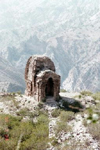 |
==The
Salt Range temples (c.700's-900's): During this period
the
Turko-Hephthalite "Hindu Shahi" kings rule in Kabul and Ghaznah
(northern
Afghanistan) and northern Pakistan. They build a number of Hindu
temples,
which join the many earlier Buddhist stupas in the region. A
distinctive
local "Gandharan" architectural style develops. Some of the temples
from
this period in the Salt Range mountains are of great beauty and
interest:
*Michael
Meister*. During this period the Brahmi-based Sharda script (*koausa*)
also develops in the region. |
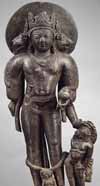 |
==Kashmir
under Lalitaditya (c.730-50): "Under King Lalitaditya,
Kashmir,
the leading power in the Punjab, serves as a major artistic and
cultural
center in North India. Monumental structures are built. Western Asian
and
Hellenistic influences are prominent, and both Hindu and Buddhist
religious
sites are patronized. Kashmir is a major center of Buddhism until the
late
eighth and ninth century, when Shaivism also becomes popular. It
is also an important center of Sanskrit learning up to the twelfth
century"
(--Met) |
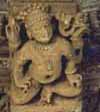 |
==Osian,
near Jodhpur in the Thar Desert, becomes a major stop on the caravan
trade
routes, and flourishes for the next four centuries or so; today sixteen
Hindu and Jain temples (700's-1000's) survive to recall its glory days.
Images: *art
and archaeology*; *Berger*;
*sachmet*. [*Routes*] |
 |
==The
Kailashnath Temple at Ellora (c.757-83): Sponsored by
Krishna
I of the Rashtrakuta dynasty, the Kailashnath Temple is India's largest
rock-cut temple--and a magnificent, astonishing achievement both
technically
and artistically. Images of Ellora: *DSAL*;
*Berger*;
for Kailashnath: *art
and archaeology*. [*Routes*] |
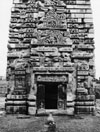 |
==Bhubaneshwar
and Puri and other large temples (c.750): The
Kailashnath
temple at Ellora marks the end of the era of rock-cut temples. Now new
large temple complexes begin to be built that are "constructed" rather
than carved out. Among the earliest are those in Bhubaneshwar and Puri,
in Orissa. Image sets: *DSAL*;
and Berger on *Puri*
and *Bhubaneshwar*.
Later on (c.1000), the superb Lingaraja and Rajarani temples are built
at Bhubaneshwar. Discussion: *India
Nest*. Meanwhile, in Java, the great Buddhist complex of *Borobudur*
takes shape. [*Routes*] |
 |
==Dynasties
constantly rising and falling: "The Rashtrakutas, a
Chalukya
feudatory dynasty, overthrow their rulers and attain imperial status,
absorbing
smaller principalities such as the Kalachuris. The Rashtrakutas expand
from the Deccan into South and Central India, and share control of the
subcontinent with the other major powers of the period: the
Gurjara-Pratiharas
in the north, the Palas in the east, and the Pallavas in the far south.
The Later Chalukyas, ruling from their capital at Kalyani (in
present-day
Mysore), displace the Rashtrakutas in the eighth century" (--Met).
In short, business as usual in South Asia. |
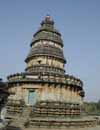 |
==Shankaracharya
(c.700-800):
"The philosopher Shankaracharya articulates and propounds the Advaita
(nondualistic)
school of monotheism, one of the six traditional orthodox schools, or
darsana,
of classical Indian philosophy that developed from the sixth to the
third
centuries B.C." (--Met).
His works include *The
Crest-jewel of Wisdom*. Discussion: *Hinduism
Today*. [*Routes*] |
|
|










